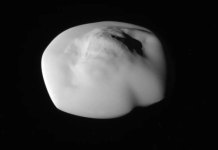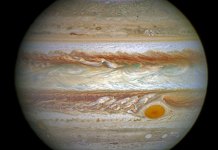NASA: An Independent Agency, NASA (The National Aeronautics and Space Administration), has sent some beautiful and breathtaking pictures of Mars through their MAVEN mission. These images show the ultraviolet glow on Mars. These photos were taken by Ultraviolet Spectrograph on the MAVEN (Mars Atmosphere and Volatile Evolution Mission) which gives us the view of the planet and its atmosphere. The pictures show the dynamics which was invisible earlier.
NASA said in a statement that, “these night glow maps are used to show the circulation of the wind at high altitudes on the planet.” The pictures also reveal the amount of ozone changing with seasons and how afternoon clouds are forming over Martian volcanoes. Nightglow is a common planetary phenomenon where there is no external light but still the sky faintly glows.
The reason behind Mars emitting ultraviolet glow is because of the chemical reaction that occurs on Mars day side which causes glow on Mars night side. When ultraviolet light from the sun breaks down molecules of nitrogen and carbon dioxide which result in atoms carried by high altitude wind around the planet.
On the Mars night side, nitrogen and oxygen atoms collide to form nitric oxide molecules. This happens when the wind brings the atoms to lower altitudes. Their combination releases extra energy which turns out to be ultraviolet light. There are series of photographs which shows the rotation of Mars for about seven hours, over a quarter of a Mars day.
The left part of the planet depicts morning, and the right part is afternoon. Volcanoes which are topped with white light are moving across the disk. Olympus Mons, Mars tallest volcano is a dark region near the top of the images along with a small white cloud which grows during the day.
This is the first time that the beautiful images have been captured, but the emission was predicted way before. These pictures are helpful to understand the Martian seasonal and daily behaviour as per the researchers.



